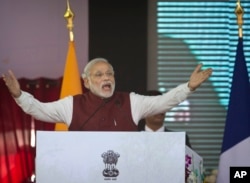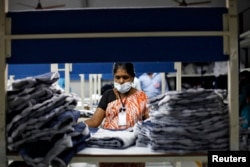India is making an aggressive push to become a global manufacturing hub at a week-long event being attended by thousands of industry leaders in the financial capital, Mumbai. But businesses say success will hinge on the government’s ability to fast track promises to make the country an easier place to do business.
Calling on investors to take advantage of India’s cheap labor and growing economy, Prime Minister Narendra Modi reiterated pledges of ushering in business friendly policies. “India is blessed with 3 ‘Ds’, Democracy, Demography and Demand, to this we have added another D “Deregulation,” he told the gathering at the “Make in India” event.
The high-profile event, which concludes Thursday, has attracted attention – with participants including Swedish Prime Minister Stefan Lofven, Finland's Prime Minister Juha Sipila, and senior officials from Germany, Japan and other countries besides representatives of many global corporations.
Emulating China
It is all part of an ambitious initiative launched a year and a half ago to emulate China’s runaway success in becoming an export powerhouse. The aim: to ramp up manufacturing to 25 percent of gross domestic product from the existing 17 percent by radically transforming the bureaucratic hurdles, complex regulations and shoddy infrastructure that have deterred investment in Asia’s third largest economy.
The government’s bid has met with some success – foreign direct investment nearly doubled last year to an estimated $59 billion.
Some pledges of investment have flowed in -- London-based Vedanta Resources promised an investment of $3 billion to set up the country’s first plant to manufacture LCD panels and Foxconn last year pledged to invest $5 billion to establish an electronics manufacturing plant. Others putting up new facilities or expanding existing factories include carmakers BMW and Ford and chocolate manufacturer Mars.
But economists warn the government’s pitch for “Make in India” could remain a mere slogan unless there are speedier changes in regulations in areas critical for manufacturers, such as land, labor and power.
State governments
Domestic businesses – who are still at the heart of Indian manufacturing – complain that is not happening.
A.K. Jain, the commercial vice president of one of India’s largest apparel exporters, Orient Craft, says they are finding it tougher to stay competitive after the Haryana state government, where many of their factories are located, raised minimum wages by about 20 per cent last October. With wages constituting a major chunk of production, that has raised costs versus apparel manufacturers in countries such as Bangladesh and Vietnam.
“We have become scared to increase the manufacturing base because we do not know whether we will be able to survive under this growing cost or not..the cost of electricity, there are so many things,” said Jain, whose company employs nearly 30,000 people and is one of northern India’s largest apparel exporters.
Corporations say while the federal government is promising deregulation, most states have not relaxed rigid labor laws, acquiring land remains difficult, taxes are high and power continues to be expensive and unreliable.
Rafeeque Ahmed, a businessman and former head of the Federation of Indian Export Association, feels state governments are not in step with the federal government’s call to ease the path of doing business.
“Ninety percent of the work is with the state governments, the licensing, the pollution, the factory inspection, everything -- the approval has to be given by the state and I don’t see any urgency with the state government on this. This is worrisome,” he said.
Robust growth
Despite such deterrents, experts say India could draw large scale investment from those attracted by the huge market of 1.2 billion people in a country whose economy is posting over 7 percent growth at a time when most major economies are faltering.
However, several economists have raised questions about those growth numbers, which are being calculated using a new method that India says is closer to the international formula.
Economist Rajiv Kumar at New Delhi's Center for Policy Research points out that many are taking those numbers with “a pinch of salt” and seeking more clarity on India’s growth rate. “So unless that happens people will just remain unclear as to where the Indian economy is, whether it is treading water, it is recovering, it is not doing so well, and that of course affects investor sentiment,” he said.
The jury is still out on whether India will meet with success in its campaign to woo global manufacturers and create millions of much-needed jobs.
Experts say while the campaign has attracted attention, most investors will remain in a wait and watch mode until they see more changes on the ground in a country whose ranking in the World Bank’s index for Ease of Doing Business improved last year, but still remains a lowly 130 among 189 countries.










